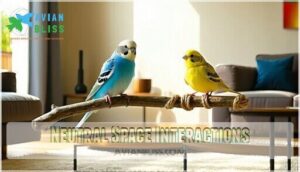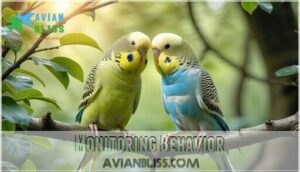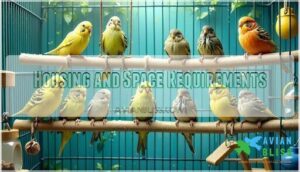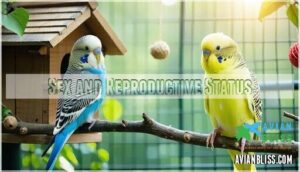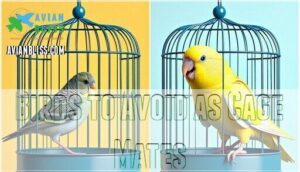This site is supported by our readers. We may earn a commission, at no cost to you, if you purchase through links.
 When you’re searching for birds you can keep with budgies, you’ll want to look for gentle, similar-sized companions.
When you’re searching for birds you can keep with budgies, you’ll want to look for gentle, similar-sized companions.
Finches, canaries, and doves usually fit the bill—they’re peaceful and don’t ruffle feathers.
Steer clear of lovebirds and larger parrots, though; they can be bullies in a shared space.
Always introduce new birds slowly, like meeting a new neighbor over the fence before sharing a backyard barbecue, and give each bird space, plenty of perches, and watch for signs of stress, as mixing species can be like blending families—it takes patience and planning.
Stick around for tips on keeping the peace in your flock.
Table Of Contents
- Key Takeaways
- Choosing Compatible Birds
- Introducing New Birds to Budgies
- Factors to Consider for Co-Habitation
- Birds to Avoid as Cage Mates
- Ensuring Similar Environmental Requirements
- Managing Stress and Aggression
- Creating a Harmonious Mixed Aviary
- Frequently Asked Questions (FAQs)
- What is the best companion for a budgie?
- What can you keep with budgies?
- What is the best pair for budgies?
- What is a budgie’s natural enemy?
- Can budgies live with other pets like cats?
- How to handle budgie jealousy over companions?
- Do budgies need company when humans are absent?
- What toys are best for multiple birds?
- Should budgie companions have similar sleep schedules?
- How do budgies react to new bird sounds?
- Conclusion
Key Takeaways
- Choose gentle, similar-sized birds like finches, canaries, or doves as companions for your budgie.
- Always introduce new birds slowly in neutral territory and watch closely for stress or aggression.
- Avoid housing budgies with lovebirds, parrotlets, cockatiels, or larger parrots due to aggression and safety risks.
- Make sure all birds have enough space, compatible diets, and similar environmental needs to keep the peace.
Choosing Compatible Birds
When choosing compatible birds for your budgie, you’ll want to focus on species that share similar size, temperament, and social needs.
Conures, finches, doves, and canaries typically make excellent companions since they’re gentle, non-aggressive, and have compatible dietary requirements.
Conures
While conures can be compatible with budgies, you’ll need careful supervision and species compatibility planning.
Green-cheek conures work better than larger species like Sun conures, whose powerful beaks pose risks to smaller budgies.
These intelligent parrots share similar social needs but require territorial management due to their assertive nature.
Conure temperament varies by species, with some showing more aggression than others.
Proper conure training and enrichment activities help reduce territorial behavior.
House them separately initially, allowing supervised interactions in neutral spaces.
Housing them together is generally not recommended.
With patience and proper conure health monitoring, these vibrant companions can coexist peacefully, though separate caging remains safest long-term.
Finches
These delightful small birds create excellent companions for budgies in mixed-species aviaries. Finch varieties like zebra and society finches share similar social needs and peaceful temperaments with budgies.
Their active nature and non-aggressive finch temperament make them ideal cage mates when proper space and care are provided. Finches are globally distributed and found across continents.
- Finch diet consists of small seeds that complement budgie nutrition requirements
- Finch health monitoring prevents respiratory issues common in mixed aviaries
- Finch enrichment activities stimulate both species’ natural foraging behaviors
Doves
Diamond doves bring tranquility to your aviary with their gentle nature and peaceful coexistence alongside budgies.
Diamond doves add calm energy to your aviary, blending beautifully with the lively spirit of budgies.
Their dove temperament perfectly complements budgie energy, creating harmonious mixed-species environments.
Here’s why doves make excellent compatible bird species:
- Dove varieties like diamond doves share similar housing requirements with budgies
- Dove communication remains quiet and non-threatening to budgie flocks
- Dove care routines align with standard budgie maintenance schedules
- Peaceful coexistence develops naturally through their calm, non-aggressive personalities
Doves with budgies create balanced aviaries.
Canaries
Canaries offer peaceful companionship for budgies with their gentle temperament and melodic songs.
These small birds share similar dietary needs and housing requirements, making canaries with budgies highly compatible bird species.
Their calm nature reduces stress while their vibrant canary colors and canary songs create a harmonious environment for successful budgie compatibility.
Introducing New Birds to Budgies
When introducing new birds to your budgie, you’ll need to start with neutral space interactions to help them get acquainted safely.
You must monitor their behavior closely during these first meetings, watching for signs of stress or aggression that could indicate compatibility issues.
Neutral Space Interactions
Safe introductions happen when you create neutral space interactions that put both birds at ease.
Here’s how to master supervised socialization:
- Choose neutral territory – not either bird’s established cage area
- Start with short sessions – 10-15 minutes prevents overwhelming stress
- Watch body language – puffed feathers signal stress, relaxed postures show comfort
- Provide multiple perches – resource availability reduces competition between birds
- Use positive reinforcement – reward calm behavior with treats
This gradual introduction process builds budgie compatibility while ensuring stress reduction for both companions.
Monitoring Behavior
Watch closely for aggression signs like lunging, biting, or aggressive vocalizations during bird interactions.
Notice stress signals including feather plucking, excessive panting, or withdrawn behavior that disrupts normal social dynamics.
Body language reveals everything – fluffed feathers often indicate fear, while relaxed postures suggest comfort.
Budgies experiencing bullying may show decreased appetite or activity.
Social cues help you understand their developing relationship and facilitate successful monitoring of their bird behavior.
Factors to Consider for Co-Habitation
When you’re thinking about keeping budgies with other birds, you’ll need to look at species compatibility, space, health, and diet.
Paying attention to these factors helps you create a safe and comfortable home for all your feathered friends.
Species Compatibility
Species compatibility forms the foundation of successful budgie companionship.
When selecting budgie friendly birds, consider these key factors:
- Temperament Matching – Choose calm, non-aggressive species like finches or canaries
- Size Differences – Avoid pairing with substantially larger birds that might intimidate budgies
- Social Needs – Select companion birds with similar flock mentalities and activity levels
Budgie companion birds should share compatible social structures and lifespan variance considerations for long-term harmony.
A suitable budgie and finch cage is essential for their cohabitation.
Housing and Space Requirements
Providing adequate housing space prevents territorial disputes between budgie companion birds and their cage mates.
Your cage size should allow each bird to spread its wings fully without touching another bird or the cage walls.
Consider flight space requirements when selecting housing – cramped quarters lead to stress and aggression.
Install multiple perch placement options at different heights to create separate areas for each bird.
Add toy variety throughout the cage to prevent competition over resources.
Proper housing and space requirements guarantee your budgie’s companions thrive together peacefully in a well-designed environment with separate areas.
Health and Dietary Needs
When selecting companion birds for your budgie, matching their nutritional needs prevents health complications down the road.
You’ll want to verify that all species can thrive on a shared diet while watching for signs of nutritional deficiencies or food allergies that could impact the entire flock’s wellbeing.
- Vitamin A deficiency commonly affects budgies and compatible species like finches and canaries
- Calcium requirements increase for egg-laying females across all bird species in your aviary
- Dietary supplements may be necessary when housing multiple species with varying nutritional needs
- Food allergies can develop in mixed aviaries, requiring careful monitoring of each bird’s response
- Preventative care includes regular health checks to catch nutritional deficiencies before they become serious
Sex and Reproductive Status
Understanding your budgie’s sex and reproductive status helps create stable cage mate relationships.
Male budgies typically bond better with each other, while females can show territorial behavior during breeding season.
Hormonal changes affect all birds differently, so consider each bird’s individual temperament.
Monitor for increased aggression during nesting periods, as breeding behavior can disrupt peaceful cohabitation between species.
Birds to Avoid as Cage Mates
While many bird species can safely coexist with budgies, you’ll need to avoid certain companions that pose serious risks to your feathered friends.
Some birds that seem compatible at first glance can actually become aggressive, territorial, or physically dangerous when housed together with budgies.
Lovebirds
While many bird enthusiasts consider lovebirds as potential budgie companions, this pairing often creates more problems than harmony.
Lovebird temperament can clash dramatically with budgies’ social nature, leading to territorial disputes and stress for both species.
Consider these challenging lovebird characteristics that make them unsuitable cagemates:
- Territorial behavior – Lovebirds aggressively defend their space from budgies
- Different dietary needs – Lovebird diet requirements don’t match budgie nutrition
- Intense bonding patterns – They form exclusive pairs, excluding other birds
- Aggressive sounds – Lovebird sounds can stress peaceful budgies
- Size differences – Despite similar appearance, behavioral incompatibilities persist
Keep these colorful birds separate for everyone’s well-being.
Cockatiels
Despite their charming personalities and long lifespans, cockatiels pose compatibility challenges with budgies. Their territorial nature and size differences create stress during cohabitation. Cockatiel temperament shifts dramatically during breeding season, triggering unexpected aggression toward smaller companions.
They’re often found in Australia’s open grasslands.
| Cockatiel Care | Budgie Needs | Compatibility Issue |
|---|---|---|
| Larger cage requirements | Smaller space needs | Housing conflicts |
| Calcium-rich diet | Standard seed mix | Nutritional differences |
| Quiet temperament | High activity levels | Energy mismatches |
| Territorial behavior | Social dynamics | Dominance problems |
| Cockatiel training focus | Group interaction | Individual attention needs |
Cockatiel behavior and cockatiel health requirements differ substantially from budgie care, making separate housing the wisest choice for both species’ wellbeing.
Parrotlets
In regards to bird compatibility, parrotlets with budgies usually spell trouble.
Parrotlet temperament is bold and territorial, making peaceful cohabitation tough.
Here’s why you should think twice:
- Parrotlet Aggression: Quick to defend space.
- Parrotlet Diet: Needs differ from budgies.
- Parrotlet Housing: Extra attention required.
To guarantee their well-being, consider the appropriate cage size.
- Parrotlet Size: Small but mighty, often intimidating budgies, due to their aggressive behavior.
Indian Ringnecks
Indian Ringnecks pose substantial challenges for budgie companions due to their territorial behaviors and demanding nature.
These medium-sized parrots require extensive Ringneck Training and specialized Ringneck Care that differs from budgie needs.
They’re known to be generalist feeders, posing a risk to various crops and ecosystems.
| Compatibility Factor | Indian Ringneck Challenge |
|---|---|
| Temperament | Territorial and nippy behavior |
| Space Requirements | Need larger cage size than budgies |
| Attention Needs | Require extensive daily interaction |
| Diet Complexity | Specialized Ringneck Diet requirements |
Their talkative, attention-seeking personality can stress budgies.
Species compatibility suffers when monitoring aggression becomes constant.
Ringneck Health needs also differ considerably from budgies, making shared care complicated.
Larger Parrot Species
While Indian Ringnecks present challenges, larger parrot species like macaws and cockatoos create serious safety concerns for budgies.
These powerful birds can accidentally harm smaller companions through their size and strength.
Size Compatibility issues make cohabitation dangerous.
An avian veterinarian would strongly advise against housing these species together due to:
- Aggression Risks – larger parrot species can unintentionally injure budgies during play
- Training Challenges – different enrichment needs require specialized care approaches
- Health and dietary needs conflicts complicate proper nutrition for both birds.
Monitoring behavior becomes nearly impossible when size differences are extreme.
Supervised interaction might work briefly, but species compatibility remains poor.
Keep your budgie safe with appropriately sized companions.
Ensuring Similar Environmental Requirements
When housing budgies with other bird species, you must make certain all birds share similar environmental needs to prevent stress and health issues.
Matching temperature preferences, humidity levels, and lighting requirements creates a comfortable habitat where different species can thrive together safely.
Diet and Nutrition
Nutritional needs matter when choosing cage mates.
Your birds need similar seed variety and fresh foods to thrive together.
Check each species’ dietary needs before mixing them.
Quality bird food prevents conflicts over resources.
Consider supplementation if needed, but consult your vet first.
Clean water quality keeps everyone healthy.
Match diet and nutrition requirements for peaceful cohabitation success.
Habitat and Environment
Just like nutritional balance, your bird environment needs careful attention to keep all species happy and healthy.
Cage Size must accommodate every bird’s wingspan and movement patterns. Temperature Control prevents stress from overheating or chills. Lighting Needs should mimic natural daylight cycles for proper sleep and activity patterns.
Bird cage arrangement affects how birds interact and claim territory.
- Perch Variety at different heights reduces competition for prime spots
- Toy Enrichment scattered throughout prevents boredom and territorial disputes
- Bird space design with multiple feeding stations minimizes food-related conflicts
Compatibility and Social Dynamics
Understanding social hierarchy within your mixed aviary creates harmony among different species.
Individual personalities matter more than species type—some budgies are naturally dominant while others prefer following.
Gender dynamics influence interactions, with males typically bonding easier than territorial females.
Watch for communication styles between species; budgies chirp frequently while finches communicate through subtle body language.
Bonding behaviors like preening indicate compatibility, while aggressive posturing signals incompatible social dynamics requiring immediate separation for successful bird companionship.
Managing Stress and Aggression
Managing stress and aggression in mixed-species aviaries requires careful attention to your birds’ behavior and body language.
Watch for subtle changes—your birds’ body language reveals stress and keeps harmony in your mixed aviary.
You’ll need to watch for warning signs like puffed feathers, aggressive posturing, or territorial disputes to maintain harmony between your budgies and their companions, which involves understanding complete concepts of bird behavior and recognizing signs of stress or aggression, such as aggressive posturing.
Signs of Stress and Aggression
While creating the perfect environment sets the foundation, recognizing when your feathered friends are struggling is equally important.
Watch for these key warning signs:
- Feather plucking or excessive preening indicates chronic stress
- Excessive screaming beyond normal vocalizations signals distress
- Biting behavior and aggressive posturing show territorial disputes
- Cage pacing reveals anxiety or frustration
Food aggression and bird bullying often escalate quickly, so monitoring these bird signs of aggression helps you address issues before they worsen.
Minimizing Conflict
Conflict-minimization in a mixed aviary is all about reading the room and keeping the peace. Watch for resource competition, dominance displays, and personality clashes among budgie cage mates and safe birds for budgies.
Give your flock plenty of space, monitor behavioral cues, and separate birds at the first sign of aggression. Injury prevention and compatibility checks are key—think of yourself as a peacekeeper in a feathered neighborhood.
Hormonal changes can also influence aggression levels.
- Gradual introductions
- Spacious cages
- Close monitoring
- Separation when needed
- Consistent routines
To ensure a harmonious environment, it’s crucial to implement these strategies, focusing on injury prevention and maintaining consistent routines.
Providing Enrichment Activities
Once you’ve set the stage for peace, it’s time to keep your budgie cage mates busy and happy.
Rotate toys often—Toy Rotation keeps things fresh and prevents boredom.
Offer Foraging Opportunities with treat puzzles or hidden seeds to spark curiosity.
Training Games, like simple tricks, boost confidence and bond you with your birds.
Add bird-safe plants for Sensory Stimulation and encourage Social Interaction among compatible species.
These activities help safe birds for budgies thrive, ensuring the best budgie companions create a lively, harmonious aviary where everyone feels at home.
Creating a Harmonious Mixed Aviary
When you set up a mixed aviary, you need careful planning, the right environment, and close observation to keep all your birds safe and healthy.
By choosing compatible species and meeting their needs, you can create a balanced space where budgies and their companions thrive together.
Research and Planning
Before adding new birds, take time for careful Species Research and Space Assessment.
Think about compatibility, social dynamics, and Health Considerations—just like picking roommates.
Temperament Analysis helps you avoid drama.
Plan for a Long-Term Commitment, not just a quick fix.
Check with an avian veterinarian to confirm everyone’s environmental needs are met, so your flock stays happy and healthy together.
Providing a Suitable Environment
Anyone hoping for a peaceful aviary should focus on the basics.
Budgies and their companions need a roomy cage, fresh air, and the right temperature.
Mimic sunlight with full-spectrum lighting, and keep noise levels calm.
Meeting these environmental needs helps all birds feel at home.
Compatibility grows in a setting that feels safe and welcoming.
- Cage Size
- Air Quality
- Temperature Control
- Lighting Needs
- Enrichment Options
Monitoring and Adjusting
Every flock has its ups and downs, so keep a close watch on your birds’ social dynamics.
Spot Stress Signs, Behavior Changes, or aggression early.
Use Cage Adjustments and Gradual Changes to support compatibility.
Monitor resource competition and bird introduction to keep peace.
Here’s a quick reference table:
| Stress Signs | Cage Adjustments | Social Dynamics |
|---|---|---|
| Feather plucking | Add perches | Watch new bonds |
| Loss of appetite | Increase space | Note aggression |
| Hiding | Separate cages | Track interactions |
| Excess noise | Rearrange toys | Balance resources |
The key to maintaining harmony is to identify potential issues before they escalate, making Cage Adjustments and observing Social Dynamics crucial.
By following these guidelines and being vigilant, you can create a more peaceful and healthy environment for your birds.
Frequently Asked Questions (FAQs)
What is the best companion for a budgie?
Funny how budgies, so social, still need the right roommate.
Your best bet? Another budgie—ideally a male.
They share space, food, and chatter, keeping each other happy, healthy, and entertained, like lifelong friends in a cozy flock.
What can you keep with budgies?
You can keep budgies with canaries, cockatiels, finches, diamond doves, and conures, as long as you introduce them slowly.
Make sure everyone has enough space, food, and perches to avoid squabbles and stress.
What is the best pair for budgies?
Pairing two male budgies is your safest bet—they get along like old friends, sharing songs and preening.
If you’re feeling adventurous, cockatiels or canaries can also make peaceful, lively companions with proper introductions and space, which allows them to thrive as peaceful companions.
What is a budgie’s natural enemy?
If danger had a face, it’d be predators like cats, snakes, and hawks for your budgie.
In the wild, these hunters see budgies as a quick snack, so always keep your feathered friend safe indoors.
Can budgies live with other pets like cats?
You can have budgies and cats in the same home, but never leave them together unsupervised.
Cats are natural hunters, and even the friendliest feline might see your budgie as a toy or snack.
Always prioritize safety.
How to handle budgie jealousy over companions?
When you spot jealousy, give your budgie extra attention, rotate toys, and offer treats during group time.
Watch for squabbles—sometimes a little space or separate play sessions helps everyone feel secure and included.
Do budgies need company when humans are absent?
When you’re away, your budgie can feel like a lone wolf in a big, empty forest.
Having a feathered companion helps prevent boredom and loneliness, keeping your little friend happier, healthier, and more active overall.
What toys are best for multiple birds?
Imagine a playground bursting with swings and slides—your birds crave that excitement!
Offer ladders, ropes, mirrors, and chewable toys.
Rotate items weekly, ensuring everyone gets a turn, stays mentally sharp, and avoids squabbles over favorites.
Should budgie companions have similar sleep schedules?
You’ll want your birds to have similar sleep schedules, since mismatched routines can cause stress or disrupt rest.
Birds need about 10-12 hours of darkness nightly, so syncing their bedtime helps everyone stay healthy and happy.
How do budgies react to new bird sounds?
Like a curious detective, your budgie perks up when hearing new bird sounds, responding with alertness or mimicry.
You’ll notice head tilts, chirping, or even cautious silence, as they gauge if these sounds signal friend or foe.
Conclusion
Finding birds you can keep with budgies isn’t like assembling the Avengers—there’s no magic team, just careful choices.
Stick with peaceful, similar-sized birds like finches, canaries, or doves.
Always introduce new friends slowly, watch for stress, and provide enough space for everyone.
Avoid aggressive or much larger species.
By understanding each bird’s needs and social habits, you’ll create a balanced, healthy flock.
Remember, patience and observation are key when mixing birds you can keep with budgies.

